#south carolina art shows
Explore tagged Tumblr posts
Text


This mural was created by Lara Nguyen in 2016 for The Refinery in Asheville, North Carolina. The local artist and teacher’s design was chosen for the building by the Asheville Area Arts Council.
From a Mountain Xpress article about the work-
Bowerbirds and butterflies decorate the building’s facade. Nguyen considers the former “the artists of the bird world.” Each year, for up to six months, the male bowerbird will spend its days building arches made of straw. He will then gather brightly colored objects and place them outside the construction in order to attract mates.
“They perform,” says Nguyen. “They use the hole [of the arch] as a stage. … They’re also great mimickers and singers. I thought that was interesting. They’re like actors, performance artists, builders, makers, collectors, [and] in some way they’re painters. They pick certain colors and situate them.”
Nguyen saw the creature as a perfect symbol for The Refinery Creator Space. She lists off the various types of artists (painters, photographers, sculptors, filmmakers, fiber artists…), in addition to the art-based organizations (Asheville Darkroom, Asheville Makers, The Bright Angle, Local Cloth and Mechanical Eye Microcinema) that now call the space their home. She views her mural, with its bright colors and visual appeal, as a way to help facilitate traffic; a way to intrigue the public to step inside and support the arts.
More recently, Nguyen contributed work to the 2023 annual ArtFields event in Lake City, South Carolina. The two pieces are from her series “Letters to My Children”.

Her statement about these works-
“Strong Arms” & “Keep Going” are from a series entitled “Letters to My Children.” I was diagnosed with uterine leiomyosarcoma in July 2018 when my kids, Atticus and Moon, were 7 & 9 years old. In January 2020, my lung collapsed and I underwent a lobectomy. Now with a stage 4 cancer diagnosis I have found myself up at all hours worrying about dying before my kids are grown. When I couldn’t sleep, I wrote letters to them, recording their favorite recipes and my fondest memories of them for them. In 2021, I decided to share my writing with them instead of saving all this pondering in a box for later. Making and sharing this work has allowed us to cry and grieve together, which, in turn, has opened up space to truly be honest and present for one another while we are all still alive. With my children’s permission, I present slices of difficult conversations we have had to a wider audience in hopes of easing any load the viewer might be carrying on their own personal journey.
#lara nguyen#asheville murals#asheville street art#the refinery avl#ArtFields#south carolina art shows#art#asheville artist#painting#photography#mixed media#bowerbird#street art#north carolina murals#murals#public art
5 notes
·
View notes
Text

"Hey baby, bet I could help you with your daddy issues!"
~
"Pft- five," Simmons snorted, leaning on Tucker's shoulders. "Out of ten." "Aw c'mon, really?" He groaned. "Why'd that one get such a low score?" "It just- it sounded more creepy than flirty?" "I think that's just the Donut-effect kicking in, man," "Yeah, well, try again then because no one can undo the Donut effect," "Tell me about it. Okay, okay... hey baby-"
#rvb#red vs blue#rvb tucker#rvb simmons#simmtuck#oh no whats their ship name uh#simmucker? tuckons?#imma go w simmtuck to be safe but lmaooo u know its a rarepair when#part two of 'fuck you -grimmons your tuckington-'#or tuckingtons your grimmons if you must#their dynamic is tucker is enamored and simmons is like vibing bc i realized simmons is lowkey tucker's most popular ships typed#congrats tucker you like the uptight screechy know-it-alls who are bad at showing they care#hows that for a character read#i still think this is largely tucker being the driving force and simmons is like “uhm? okayy?” but also?? leader tucker?? being competent#and maybe a lil bossy but when he says 'fuck yeah nice one simmons' he MEANS it and man that does things to simmons brain#theres a 50/50 chance of them being bitchy mean girls tm or being useless nerds and not even they know where the line is sometimes#gonna give carolina and wash flash backs to york(tucker) and south(simmons) hanging out in the best and worst ways possible#do you see the vision#if grif and donut find out tucker got simmons to wear denim they will RIOT#my art#batsy art
54 notes
·
View notes
Text
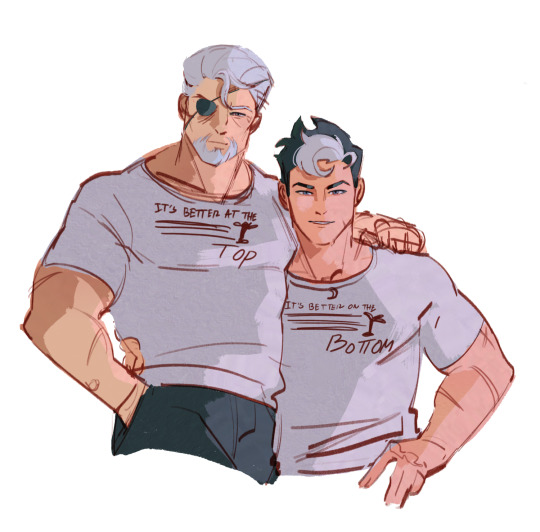
they show up to the family dinner like this
#sladejay#jayde#my art /#idea courtesy of the jayde server <3 <3#south carolina has…..interesting advertising shirts apparently!#you know that post where it’s like ‘my sister showed up to dinner with my boyfriend’s dad’ or something#and the father goes out to mow the lawn in stress. bruce vibes
331 notes
·
View notes
Photo

this episode fucked me up . why did they do him like that.
#bro if jorgen showed me the stuff that he showed timmy ab MY LIFE i would straight up just jump into that reviene myself#how is turner mentally sound in canon. this cannot be good to hear as a ten yr old#:shakes butch hartman: CHILD ABUSE IS NOT FUNNY CHILD ABUSE IS NOT FUNNY CHILD ABUSE IS-#timmy turner#Fairly Oddparents#FOP#nicktoons#its a wishful life#eughhhhhuhuhhhhghh#art#artwork#my art#clip studio paint#OH! and i apologize for the small hiatus i went to south carolina for vacation ':]#S☆K♡
107 notes
·
View notes
Text
2024 in memoriam (part 17)






























David McCarty, 54
Bill Tobin, 83
Sam Whittingham, 97
Roman Gabriel; Jr., 83
KODA, 45
Terry A. Anderson, 76
Pete Woolley, 94
Katherine Porter, 82
Al Shaver, 96
Arthur Whittington, 68
Ed Chadwick, 90
Mai Raud-Pähn, 103
Tom Tischinski, 79
Bob Cole, 90
Roy Cross, 100
Donald Petersen, 97
Mike Pinder, 82
Korey Cunningham, 28
Ho-Nien Au, 89
Marla Adams, 85
Bishop Peter Ingham, 83
Lyle Bauer, 65
Joe Sims, 55
Aaron Thomas, 86
Bob Tyler, 91
Lesley Hazleton, 78
Mary Lentaigne, 103
Prof. Charlotte F. Muller, 103
Duane Eddy, 86
Prof. Peter Demetz, 101
#Religion#Tributes#Celebrities#Sports#Baseball#Texas#Football#Missouri#Indiana#North Carolina#South Carolina#Music#Ghana#Ohio#New York#Canada#Ontario#Art#Iowa#New Mexico#TV Shows#Hockey#British Columbia#Estonia#Sweden#Newfoundland#U.K.#Cars#Minnesota#Michigan
2 notes
·
View notes
Text
RvB tarot cards
I have once again cooked up a hypothetical tarot deck for a show I enjoy. I didn't make any art because I refuse to attempt Halo armor, but here's my pitch for which RvB character I'd assign to each of the major arcana.
0-The Fool: Franklin Delano Donut. The fool symbolizes new beginnings, and someone who is so excited to be on an adventure that they stop paying attention to the dangers around them. Donut is of course known for his vibrant enthusiasm, but he may not be the most mindful person. Despite all the dangers and near death experiences he's faces though, this plucky private just keeps on being fabulous.
1-The Magician: Frank "Doc" Dufrense. The magician is a powerful character because he stands outside the limits of the four suits, much like Doc's place beyond the constructed binary of Red vs Blue. He doesn't belong wholly to any group (and his mind doesn't even belong wholly to himself), but that won't stop him from showing up every day to make people more comfortable while they die. He is an outsider who comes to help others; it's just a question of whether he can live up to his own good intentions.
2-The High Priestess: Agent North Dakota. As an almost parental figure, the high priestess is often sought for advice and encourages cooler heads to prevail. North's place amongst the Freelancers was often defined by his role as a peacekeeper, serving as an advocate for calm and reasoned thinking in the face of bizarre circumstances. It's because of this logic and empathy that he was able to recognize Freelancer's corruption and ultimately defect from the project.
3- The Empress: Agent New York. The empress is a leader not through force but through nurturing. This suits York, who was consistently one of the highest ranked and best beloved Freelancers, in large part due to his amiable personality and willingness to listen to others. He often acted as a more passive or supportive member of the group, but his defection from the program proved that he was still an independent thinker and a leader in his own right.
4- The Emperor: Agent Carolina. In contrast to their counterpart, the emperor is the leader who maintains control through strict discipline. Carolina was the head of her squad in Project Freelancer due to her raw strength and combat ability, but she often allowed this reliance on rules and structure to go too far. She not only allowed the ranking system to control her life, but she expected her place as #1 to allow her to control the lives of others. After her time with the Reds and Blues she allowed herself to loosen up a bit, but she still maintained her domineering personality and commitment to victory.
5- The Hierophant: Col. Sarge. The hierophant is another leadership card, this one coming from a person who is entrenched in a place of authority and perhaps a bit too reliant on rules and history. Sarge is certainly a creative leader in many ways, but he also depends upon the army as the arbitrator of right and wrong; focusing heavily on receiving orders and passing them on to his subordinates. Sarge isn't completely unchangeable though, and we see in season eight onwards the sort of wild maneuvers he'll cook up on his own time.
6- The Lovers: Lopez and Sheila. This card is fairly self explanatory, I think. Two people in love! It just so happens that in this case, the happiest and most functional relationship is between a robot soldier and the enemy tank.
7- The Chariot: Agent South Dakota. The chariot is all about go-go-go. It's a card of action and movement, much like South's fiery and passionate personality. Though her impulsivity often got her benched, the limitations placed on her by the Director only added to her frustration and prevented her from getting any of that energy out in a healthy way. After Project Freelancer her main mission was always to keep moving and keep finding something new, no matter what destruction she had to leave behind.
8- Strength: Michael J. Caboose. While Caboose is of course strong in a physical sense, that's not exactly the meaning of the strength tarot card. Strength is the lion, but it's also the young woman who fearlessly scratches the lion's ears. Caboose can lift a tank, but his real power comes from the strength of his friendships and his willingness to trust anyone who comes his way. This endless optimism and determination to keep seeing the bright side of everything (even a killer robot) is what led the Reds and Blues out of many tough scrapes.
9- The Hermit: Dick Simmons. The hermit is a guy by himself, plain and simple. While Simmons craves the company of others, he often finds it easier to keep himself isolated than to deal with the complexities of humanity. If the Reds don't respect him he'll simply join the Blues and take over an empty base. He's smart, yes, but he sees his own powers as ultimate and doesn't want to be on the team if he isn't seen as essential.
10- The Wheel of Fortune: Agent Florida. As a symbol of fate and destiny, the wheel of fortune is suited to a character like Florida who may appear chaotic but ultimately pulls the strings of Blood Gulch. His personality can be a bit unpredictable at times, but Flowers is still completely in control. It's just a question of whether you've figured out his plan yet.
11- Justice: Agent Connecticut. While all the members of Project Freelancer were supposedly fighting for peace, CT is the only one who took it upon herself to keep their agency in check. The others followed of course, but she was the first whistleblower to really challenge Freelancer and uncover the twisted secrets of their organization, and she was more than willing to sacrifice her life if it meant getting that information to the right people. Though it didn't come to pass until after his death, CT was still the one who brought Project Freelancer to justice.
12- The Hanged Man: Lavernius Tucker. While the hanged man isn't exactly a cheery sounding card, what it's really about is looking at difficult situations from a creative perspective. Tucker was constantly tied up in the schemes of others (The Director, the Sangheli, Felix), but he always maintained his distinctive attitude and determination. While he would have preferred to stay the same guy he was in Blood Gulch, he proved again and again that he was more than able to adapt and evolve; thriving in lethal conflicts and becoming a hero unlike any other.
13- Death: The Meta. The Meta, like death, is not cruel or sadistic. It is simply coming for you, and you will not escape. Looking deeper though, the death card in tarot symbolizes the end to old systems and the transition to something new. The Meta was once Agent Maine, until is underwent a transformation more horrible than simply dying. It went through a metamorphosis, and in the process brought about the end of Project Freelancer and the beginning of a new era.
14- Temperance: Locus. This card is one that symbolizes balance more than anything else. As a man desperate to become a machine, Locus tried to maintain perfect control over himself. He wanted to appear solid and unshakeable, up until the bedrock of his partnership with Felix was shattered. After he turned on his partner, Locus struggled to maintain a different kind of balance; between the man he was and the man he wants to be.
15- The Devil: Felix. Well this one is pretty simple. The devil as a card is about evil, yes; but it's also about control and creativity. Felix found joy in his ability to wrap the people of the New Republic around his finger, and he thrived in command of an army of space pirates. More than that though, he had fun with it. He always came up with innovative ways to destroy his enemies or intimidate his allies, and he was completely free of guilt the entire time.
16- The Tower: The Director. While death and the devil sound scary on the surface, the tower is really the most powerfully negative card in the deck. Much like Dr. Church, the tower brings misery and despair to everyone associated with it. More specifically, the screaming people falling from a lightning struck tower symbolizes divine retribution for humans who saw themselves as gods. The Director spent his later years trying to build a program that could win a war and bring back his lost love, and his favorite tool was manipulation. He always wanted nothing more than to establish his own power and prove that he could maintain complete control over the world and people around him, but it was only a matter of time before his ship crashed into Sidewinder and his bitter children found his hiding place.
17- The Star: Dexter Grif. The star is another symbol of balance, though this one is more about fairness and hope. Grif is someone who may act discontented but clearly cares deeply about the people around him, and his unshakeable demeanor holds the Reds together (as much as Sarge would hate to admit it). While he doesn't literally nourish the land and water like the star, he stays calm amidst a team of fiery tempers and is able to keep the warthog running if they ever need a getaway vehicle.
18- The Moon: Agent Washington. The moon is all about changes and illusions, perfect for someone like Wash who spent so much time blending into different personas. While Wash, like the moon, can appear dark and mysterious; he's ultimately a force for positive change amongst the Reds and Blues, who in turn inspire him to change into the best version of himself.
19- The Sun: Kaikaina Grif. Simple joy, that's what the sun is all about. In a canyon full of shitty people and a show full of angst, Kai is one of the only characters who's just here to have a good time. As crazy as things get for her brother and his friends, she'll always be waiting back at Blue Base with enough music and glowsticks to keep the party going.
20- Judgement: Agent Texas. Much like the angel on this card descends to judge mankind, Tex was dragged from the afterlife to separate the worthy from the corrupt. While she was created as a sort of toy in the Director's grief, she quickly established her own sense of identity and justice. She saw the truth of Project Freelancer and made it her mission to destroy it, doing her best to free the Alpha. In Blood Gulch and beyond she acted as a sort of avenging angel for the Blues, swooping in to save their asses and punish whoever she deemed to be worthy of punishment. In the end they all learned something from Tex and her fierce determination. Church became his own protector, and he could finally let Allison rest.
21- The World: The AI fragments. The world is a card of ultimate completion. Much like the many fragments who came from a more powerful AI, many symbols surround the vast and vibrant landscape of this card. Delta, Theta, Gamma, Omega, Beta, Sigma, Eta, Iota, Epsilon, and Alpha are all characters in their own right; but they're also pieces of a whole. They were never able to reunite fully in Red vs Blue, but they live on in the memories of Epsilon and all of us who return to the show year after year.
#woo! nourishment for my normal level of attachment to this show#i don't believe in tarot as a magic thing but i do think the cards and their associations are fun and now i'm making that your problem#red vs blue#rvb#franklin delano donut#doc rvb#frank dufresne#agent north dakota#agent york#agent carolina#sarge rvb#lopez rvb#sheila rvb#agent south dakota#michael j caboose#dick simmons#agent florida#agent connecticut#lavernius tucker#the meta rvb#agent maine#locus rvb#felix rvb#the director rvb#leonard church#dexter grif#kaikaina grif#agent washington#agent texas#epsilon rvb
61 notes
·
View notes
Text

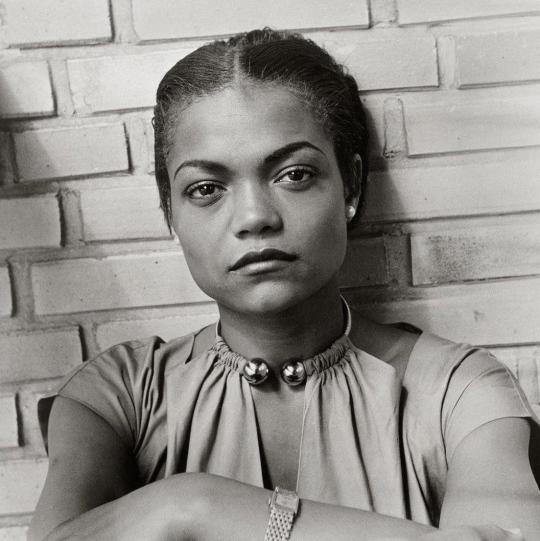
Propaganda
Glynis Johns (Mary Poppins, The Court Jester)—LISTEN, I'd let that woman's voice with all its gravely hoarseness (positive) wash over me all goddamn day, but if that's not enough she managed to play the straight woman to Danny Kaye's jester, all with her cleavage so plunging it might as well have been catapulted into the ocean right after Basil Rathbone
Eartha Kitt (Anna Lucasta, St. Louis Blues)—My friend and I have a saying: NOBODY is Eartha Kitt. A thousand have tried, and they've all come up empty and will continue to do so. Everyone knows her for something: from "Santa Baby" to Yzma in Emperor's New Groove to Catwoman to making Lady Bird Johnson cry for the Vietnam War. She was a master of comedy and sex, an extremely vocal activist, and she aged like fine wine... I honestly don't know what I can say about her that hasn't already been said, so I'll stick to linking all my propaganda. Like what else do you want from me. She was iconic at everything she ever did. Literally name another. How can anyone even think of her and not want to absolutely drown?
This is round 4 of the tournament. All other polls in this bracket can be found here. Please reblog with further support of your beloved hot sexy vintage woman.
[additional propaganda submitted under the cut.]
Glynis Johns:

She walks the line between sexy and cute. Her best role for me is in "The Court Jester as Maid Jean. She's fantastic as the soft but tough captain of the outlaw band and she looks stunning in every gown she wears throughout the film. And of course we can't forget her iconic turn as the suffragette mother, Mrs. Banks, in Mary Poppins! Also shoutout to her distinctive and beautiful voice, kind of smoky and husky. Extremely hot and set her apart from many of her peers."
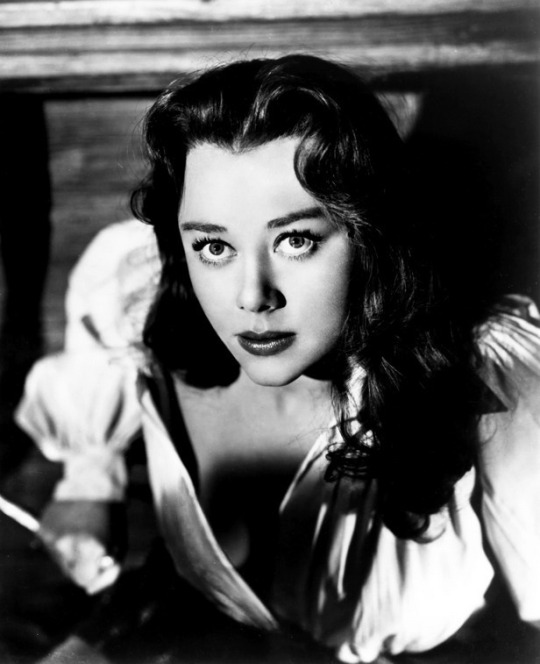
"She was amazing in Mary Poppins (the Suffragette song is severely underrated) and apparently she was Welsh? National pride! And she advocated for arts funding in Wales, which is very cool. Also, she died recently (RIP) making her one of the last survivors of the Golden Age of Hollywood, according to Wikipedia. Also also, she just has a cheeky energy I like? And her eyes are beautiful!"
"She had this wonderful wit and charm to her no matter the role and the most distinctive, striking voice!"

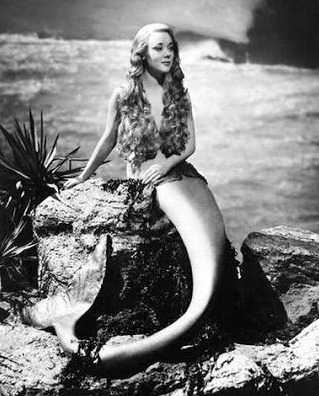
"I mean, incredibly beautiful and talented, can do drama can do comedy. And she was a mermaid."
"Like Bette Davis she has eyes to die for. Unlike Bette Davis you felt comforted by them, even when she was batting her eyelashes at you. Would glady go to Downing Street with her and throw things at the Prime minister"
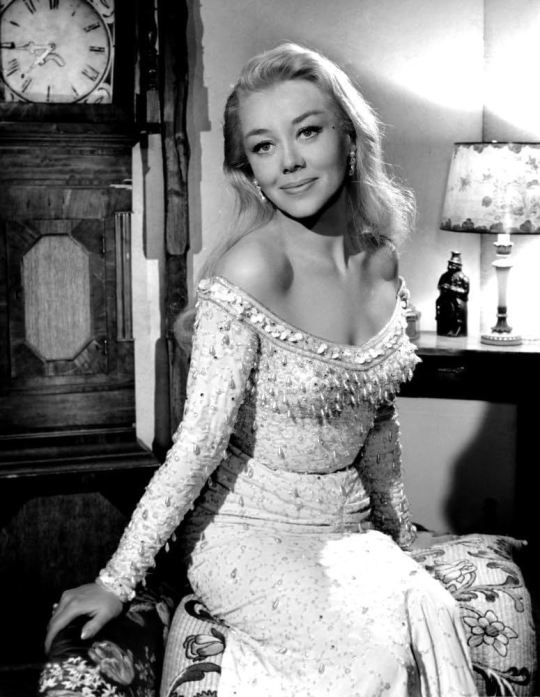
"Listen, listen. I was raised on Mary Poppins and "Votes for women! (step in time)" single-handedly taught me how to be a feminist. Also The Court Jester is one of my favourite movies of all time and she is UNBELIEVABLY gorgeous, charismatic, funny, and clever in it. She knocks several men out. Absolute icon."
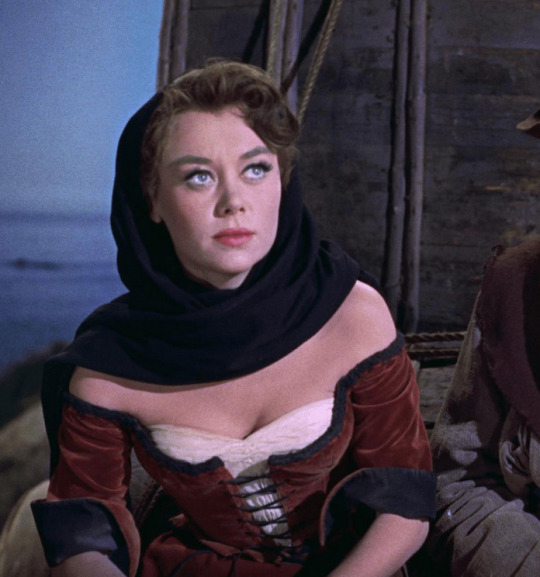
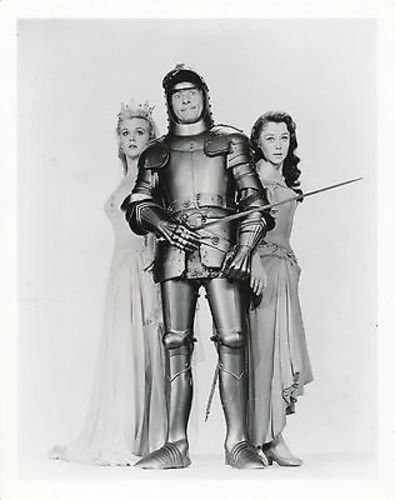
"I love Glynis Johns. Most of the reason is The Court Jester where she's a sensible and capable foil to whatever what going on with Danny Kaye at the time. She was also the first star I based an OC on. An OC that I still have to this day! Anyway here have some YouTube links love u bye"
Mermaid clip:
Court Jester (sharing a bed trope):
youtube
Court Jester (seducing the king):
youtube
"VOTES FOR WOMEN! Well, votes for this woman. Please."
youtube
Eartha Kitt:
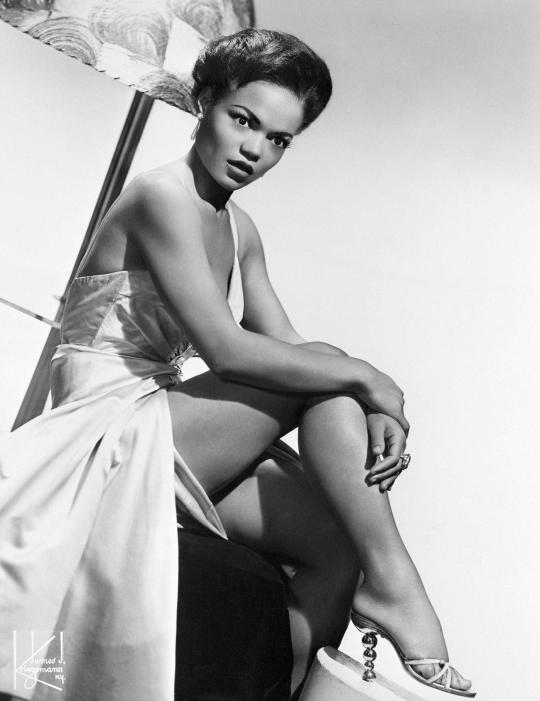
"A hot vintage woman who was not just known for her voice, beauty, poise, and presence, but also her unapologetic ways of speaking about how she was mistreated in the show business as a girl who grew up on cotton fields in South Carolina in the 1930s through the 1940s coming to Broadway first and then Hollywood."
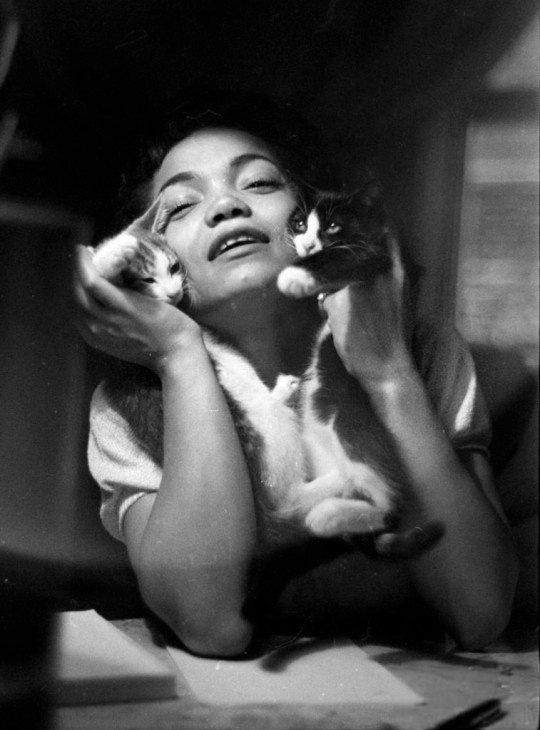
"Have you watched her sing?? Have you seen her face?? Have you heard her talk?? How could you not fall instantly in love. She makes me incoherent with how hot she is."

"She can ACT she can SING she can speak FOUR LANGUAGES she is a GODDESS!!! Although she is (rightfully) remembered for her singing, TV appearances (Catwoman my beloved), and later film roles, her early appearances in film are no less impressive or noteworthy!! She’s an amazing actress with so much charisma in every role. She was also blacklisted from Hollywood for 10 years for criticizing the Johnson administration/Vietnam War, so. Iconic. Also Orson Welles apparently called her “the most exciting woman in the world.”

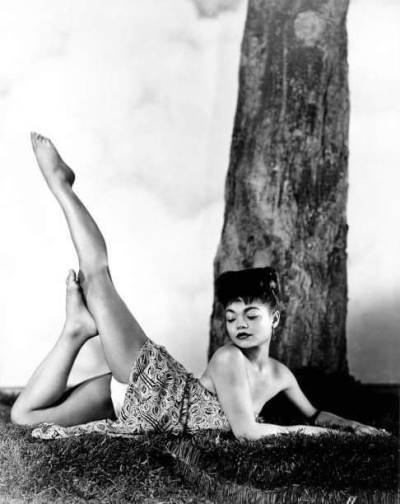
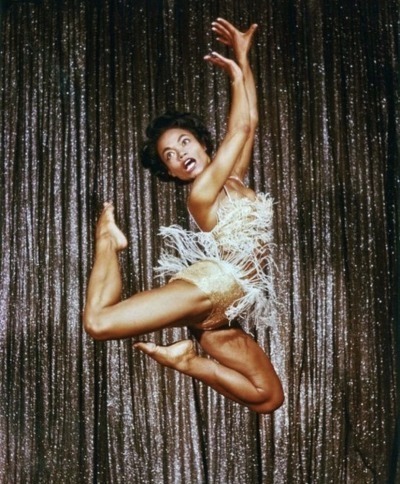

"She had such a stunning, remarkable appearance, like she could tear you to shreds with just a glance- but the most undeniable part of her hotness was her voice, and it makes sense that it's what most people nowadays know her for. Nothing encapsulates the sheer magnetism of her singing better than this clip of her and Nat King Cole in St. Louis Blues, she pops in at 2:49. Also I know it's post-1970 but her song that was cut from Emperor's New Groove is likely to make you feel Feelings."
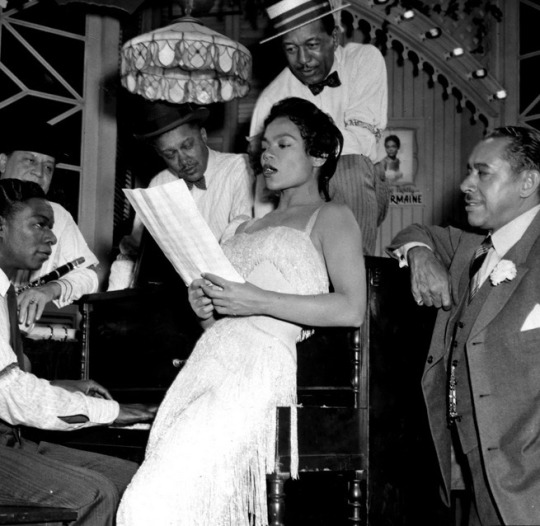
Even with as racist as Hollywood was in the 1950s and 60s, Eartha Kitt STILL managed to have a thriving career. She also once had a threesome with Paul Newman and James Dean, and called out LBJ over the Vietnam War so hard that it made First Lady Johnson cry. Eartha Kitt was talented, sexy, and a total badass activist.
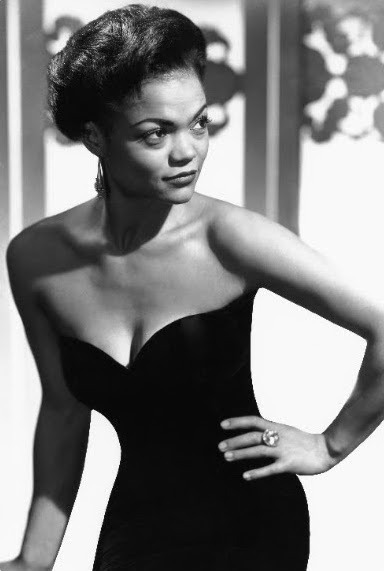
252 notes
·
View notes
Text
Random Holiday Headcanons
Happy Holidays y’all! Some holiday head canons just because... 💙🤍💚❤️
Under the cut because there’s a million 😅
Patrick
Patrick is canonically Jewish.
In my head his grandparents are more religious and give them Hanukkah gifts and when they visit the family celebrates somewhat formally.
Among his immediate family though I imagine it’s mostly his dad leading their observance of Hanukkah traditions.
Growing up he spent quite a few Christmas holidays at Arts house in New England and likes how traditional they are. Even though he teases him about how over the top it is.
Stanford age!Patrick celebrates Christmas socially. He goes to parties and events and sometimes gives gifts to his friends/partners.
Okay Dilf!Patrick is super into winter activities. He likes to go to the mountains and go sledding with the kids. He’s an okay snowboarder but often bites off more than he can chew and ends up spending more time sitting on the side of the mountain than actually snowboarding.
He’s not big into decorating but he does like to share Hanukkah traditions with the kids even if he was never that into them growing up. Especially if his sister and her family is visiting.
He’ll fry latkes and light the menorah. He likes blending the holidays and making it feel unique and special.
The kids love it because they get more gifts before and after Christmas depending on when the holiday falls.
The kids also love when Patrick tells them the Hanukkah story and the meaning behind the oil lamp burning for 8 days.
Tashi
For Stanford!Tashi the holidays are all about being with family.
Thanksgiving is always in South Carolina where her grandma(dad’s mom) lives. All her dad’s siblings (he has four) and their families show up there. Cook together… watch football and the cousins hang out which she loves because there’s a big group of them that are around her same age.
Thanksgiving night they go for a walk around her grandma’s neighborhood if the weather is mild.
For Christmas she goes to Long Island, New York to see her grandparents (mom’s side).
They have a holiday party every year on Christmas Eve with various relatives who live in and around New York (and her grandparents also invite people who are in town or may have no family to spend Christmas with).
Everyone opens their gifts together Christmas morning and the younger cousins play together. It’s less fun for Tashi because she’s the oldest. But she doesn’t mind hanging out and watching after her brothers and her little cousins.
She loves watching the Charlie Brown Christmas specials and it’s a wonderful life on Christmas Eve.
On Christmas they play board games. They’re all really competitive and monopoly is a dangerous game to pull out.
Older!Tashi can get kinda Pinteresty about decorating.
When she had her daughter she just wanted to build new traditions and those traditions generally involve traveling because of Arts career.
I imagine they visit Switzerland for Christmas time with her mom’s family as a stop off before going to Australia for the open.
They stay in cozy lodges and decorate. And light the fireplace. She likes to read the night before Christmas book she heard when she was growing up.
They visit Christmas markets and do all the snowy winter activities.
She’s a skier and is judgmental of Patrick’s tendency to just sit on the mountain most of the day (like me to snowboarders because that can’t be fun).
Art
Arts family was very into the holidays growing up
The entire house was decorated. They actually listen to Christmas music on purpose.
They wear Christmas pajamas all day. Drink cocoa and watch Christmas movies together.
His grandma would go above and beyond to make it special for him and his sisters. Making sure they built gingerbread houses and played in the snow. And that they all got tons of gifts. When they were young his grandma would make his dad sneak the gifts in on Christmas Eve at a crazy hour to make it seem like Santa came.
His tradition was him and his sisters would bring their sleeping bags in the living room and fall asleep by the tree. His oldest sister always got the couch and him and his middle sister had to sleep on the floor.
They did it well into their 20s when they were all home together. And did it with his first nephew when his oldest sister got married.
He still thinks the whole thing is magical.
Older!Art is probably the most holiday pilled (when he’s not depressed).
He over does it with the Christmas decorations. Tashi rolls her eyes like “there doesn’t need to be Christmas lights in the bathroom Art.”
He makes them carve pumpkins at Halloween and makes them build gingerbread houses on Christmas.
Lily loves it.
He helps Lily bake sugar cookies and chocolate chip cookies on Christmas Eve. And leaves them with a note for Santa and a glass of milk.
Then he dresses as Santa in the middle of the night to sneak presents under the tree while Lily is asleep. He does it no matter where they are in the world.
Later when Patrick finds out he plays Santa baby on repeat Christmas Eve morning.
Art wants to play Christmas music all the time but Tashi draws the line there unless it’s jazz or instrumental. She can’t listen to the same lyrics over and over all season.
Art is a skier but he took snowboarding lessons with Patrick and spent most of the day sitting on the mountain.
I have a million more because I’m insane but I’d love to hear yours if you want to share.
30 notes
·
View notes
Text
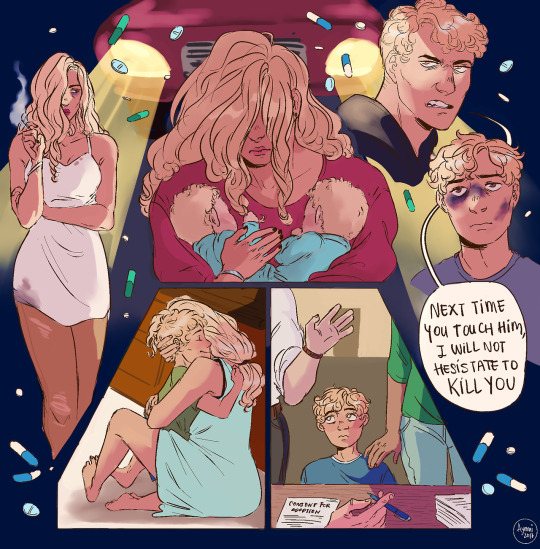
The Raven King - Chapter Seven
Day: Thursday, October 5th Time: 11:00 AM EST
"Andrew hates her, you know. Andrew's not really big on the idea of Aaron's happiness, see? So if Aaron likes Katelyn, Andrew doesn't want him to have her. Andrew might smile awful bright but he is a master of childish spite." "That doesn't make sense," Neil said. "It's complicated," Nicky said, rubbing the back of his neck as he leaned back in his chair. "I didn't really get into the gritty details last time because those aren't really Dan and Matt's business, but you're family, so I can tell you." He looked over his shoulder again. "I told you Aunt Tilda gave Andrew up, right? That's only half of it. Truth is she put both of them in the system at first. One week later she changed her mind."
"They know she gave them both up?" Neil asked. "When Andrew's foster mother called to set up that meet-and-greet, she asked Aunt Tilda how only one of them ended up in the system. Aunt Tilda told her, and Aaron heard it on the upstairs line." Nicky gestured up as if indicating Tilda's bedroom. "I don't know why the hell Andrew's foster family told him, but yeah, he knows. I'm thinking that's why he wouldn't talk to Aaron when Aaron wrote to him. He was—justifiably, I think—pissed off." "But it's not Aaron's fault," Neil said. "It was their mother's decision." "That's Andrew for you: making sense since never." Nicky spread his hands in a helpless gesture. "Finding Andrew again was a turning point for Aaron in all the worst ways. Aunt Tilda moved them cross-country, started drinking more than ever, and got heavy-handed with Aaron. Aaron got into all kinds of trouble in some sort of traumatized rebellion. He took her drugs and got into fights at school and in general grew up to be a bit of an asshole. Mom wrote me about it when I was in Germany because she was worried about him. The only good thing Aaron did in South Carolina was play Exy, and he only picked that up so games would get him out of Aunt Tilda's house. Then Dad found out about Andrew and began this years-long campaign to bring Andrew home. Told you last time, right? He wore Aunt Tilda down until she agreed to take Andrew in, then talked to the courts and Children's Services and Andrew's last foster family. He met Andrew, who apparently wasn't at all interested in a triumphant return with his mother, and introduced Aaron to Andrew. That's when things started moving. Andrew suddenly got motivated. He started behaving and toeing the line and got released on early parole about a year later." "Andrew decided he wanted a brother after all," Neil said. "So what went wrong?" "Aunt Tilda died, and Aaron blames Andrew." "Did Andrew do it?" "The night Aunt Tilda died, she and Aaron got in a fight. That's how Mom and Dad finally found out Aunt Tilda was beating on Aaron. He showed up at their place with fresh bruises and cuts. Dad called Aunt Tilda over to sort things out, but she didn't stick around long. She took Aaron and left. They didn't make it home. She went over the median into oncoming traffic and wasn't wearing her seatbelt.... It wasn't Aaron in the car. Aaron was standing in for Andrew at a study session. That was before Andrew was on his drugs, so it was a pretty easy act for Aaron to pull off. He didn't know why Andrew asked him to do it until the police called. I still don't know what happened, if Aunt Tilda panicked when she realized which son was with her or if they were fighting or if it was intentional, but... It's not like Aaron liked her, but she was his mother, you know? And Aaron never got to fix things with her, never got to understand why she was so messed up or why she messed them up so bad. Aaron can't accept that she's gone. He misses her. He can't forgive Andrew, and Andrew doesn't understand or care about how much it hurt Aaron. Stalemate."
He spoke slowly, giving himself time to think and to bleach the grief from his voice. "Andrew did care. That's what went wrong."
Art used with permission by Aymmidumps. Thank you @aymmidumps!
#aftg#all for the game#neil josten#trk#the raven king#the foxhole court#andrew minyard#palmetto state university#psu foxes#andreil#on this day in aftg#otdiaftg#palmetto state foxes#otdi all for the game#nora sakavic#the foxes#on this day in all for the game#kevin day#nicky hemmick#aaron minyard#coach wymack#betsy dobson#abby winfield#matt boyd#dan wilds#renee walker#allison reynolds#artists#aymmidumps
207 notes
·
View notes
Text
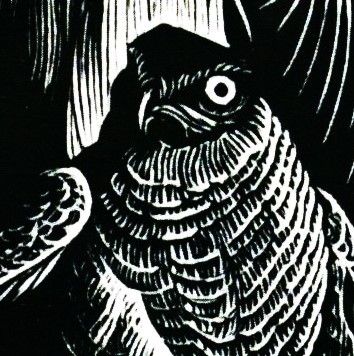


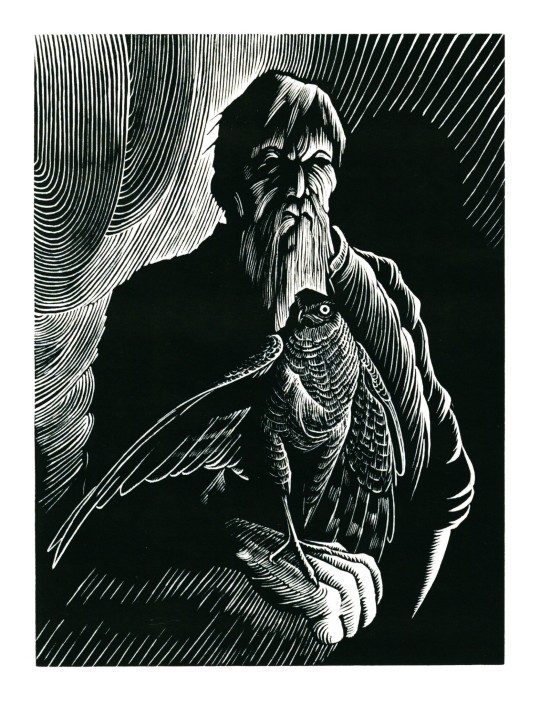
Another Wood-engraved Feathursday
JOHN MCWILLIAMS
Now here's a couple of intense fellows! The print is entitled Sparrow Hawk by South Carolina artist and engraver John McWilliams (b. 1941). The print was selected for inclusion in the Fourth Triennial Exhibition 2020-2022 of the American wood engravers society, the Wood Engravers’ Network (WEN), and this image is from the catalog for that traveling show.
McWilliams's work is inspired by Lowlands flora and fauna, so it seems a little odd that he would choose as his subject the Eurasian Sparrow Hawk (Accipiter nisus) rather than the American Kestrel (Falco sparverius), which is so common to his native habitat. Both species are used in falconry. Nevertheless, both offer something for the engraver, and we enjoy how McWilliams's Sparrow Hawk looks like it's about to take a bow.
John McWilliams received his BFA and MFA from the Rhode Island School of Design and is Professor/Director Emeritus of Georgia State University Ernest G. Welch School of Art and Design. He has received numerous awards, including the Guggenheim Foundation Fellowship and the National Endowment for the Arts Fellowship in photography. Today he maintains a studio in McClellanville, S.C. He counts as his inspirations the work of Albrecht Dürer and the German expressionists, the illustrations of Rockwell Kent, and the graphic novels of Lynd Ward and Frans Masereel. Of working in wood, he writes:
Woodcuts and wood engravings . . . have held much fascination for me. . . . The process of developing an image into a woodcut or wood engraving gives structure to my life. . . . It is such sweet irony that, although the act of creating gives my life structure, it nevertheless produces an enigma, a puzzle that others may interpret through their own lives. There are no easy answers. Such is life.
View more Feathursday posts.
View other posts with engravings from the WEN Fourth Triennial Exhibition.
View more engravings by members of the Wood Engraver’s Network.
View more posts with wood engravings!
#Feathursday#wood engravings#wood engravers#John McWilliams#Eurasian Sparrow Hawk#George Dirolf#Wood Engravers' Network#WEN#WEN Fourth Triennial Exhibition#exhibitions#exhibition catalogs#birds#birbs!
55 notes
·
View notes
Text
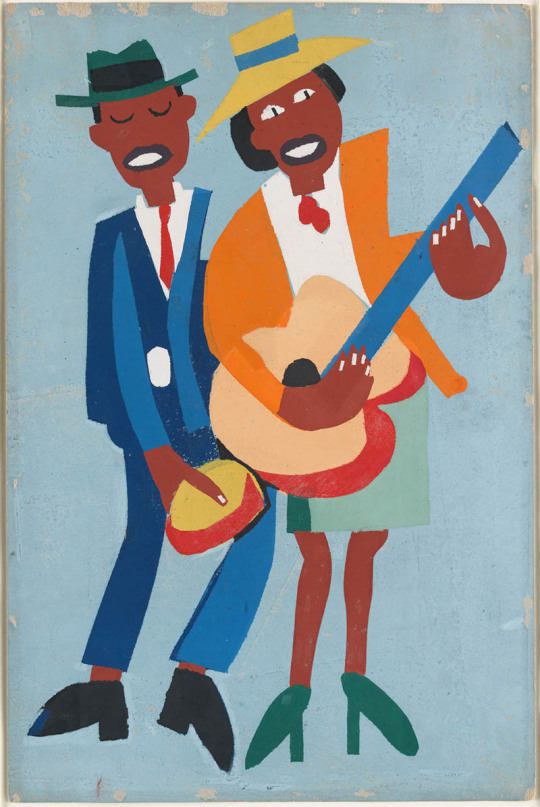
William H. Johnson, Blind Singer, ca. 1940. Screenprint with tempera additions.
Johnson was among the foremost painters of African-American life during the Harlem Renaissance. Born in South Carolina and educated in fine arts in New York and Provincetown, Johnson spent most of his time from the mid-1920s to the late 1930s in Europe, where he was influenced by Post-Impressionism and Expressionism. After achieving critical acclaim abroad, he returned to New York permanently in 1938 under the threat of war and with a desire to reconnect to his roots. The move produced a dramatic change in his work. Assigned by the government's Works Progress Administration to teach at the Harlem Community Art Center, Johnson became immersed in the sights, sounds, and people of New York's African-American community, which he captured in compositions of flat shapes, patterned designs, and brilliant colors that were distinctly modernist in their simplicity and directness.
During his lifetime, Johnson created more than seventy-five prints. While in Europe he produced woodcuts and linoleum cuts, usually with hand coloring, inspired by the raw power of German Expressionism. After returning to New York, he took up screenprint and pochoir, techniques that suited his new embrace of simplified forms and bold colors. He printed these works on assorted found papers and often completed his images by hand with tempera, making each print slightly different from the next. He frequently experimented with subjects by printing compositional variants and also rendering them in drawing and painting, each format enriching the other, but with the printed versions the most simplified of all.
Notable among Johnson's New York prints are those that capture the essence of Harlem's fashion, music, and dance. This print, entitled Blind Singer, shows a pair of musicians in an open-air performance that was common on the city's bustling streets. The composition's flatness, pure color, and orchestrated angularity endow this still image with a sense of rhythmic motion and dynamic energy. --Judy Hecker, in Deborah Wye, Artists and Prints: Masterworks from The Museum of Modern Art
Photo & text: MoMA
#vintage New York#1940s#William H. Johnson#painter#painting#Harlem Renaissance#Black painters#African-American artist#printmaker#vintage Harlem#Harlem culture
43 notes
·
View notes
Text
Androbesity
BHM Weight Gain / Masculinization
Just chapters 1-4 for now.
Chapter 1: The Campus
Nestled in the arid desert between Las Vegas and Palm Springs, far from the prying eyes of the world, lies the Androbesity Campus. A sanctuary designed for a singular purpose: to normalize and encourage obesity in adult men. This secluded haven, reminiscent of a luxury resort, is an ambitious social experiment aimed at redefining societal norms and offering a new perspective on health, community, and self-worth.
The concept of Androbesity was born from the minds of visionary thinkers who saw an opportunity to challenge the pervasive stigmas surrounding obesity. They believed in celebrating the intelligence and unique attributes of obese men, providing them a space to thrive without the constraints of a society that often judges them harshly. Thus, the Androbesity program was established, inviting one man from each U.S. state and territory, including Washington D.C., Puerto Rico, Guam, and American Samoa, to live on the campus for four years, from ages 22 to 25.
Each year, 54 men are selected based on three criteria: high intelligence, significant obesity, and a commitment to fully participating in an experimental community. These men are chosen not just for their physical attributes but also for their potential to contribute intellectually and socially to the community. By the end of the four-year cycle, the campus hosts 216 residents, creating a diverse and dynamic environment.
Located in the harsh, sun-baked desert, the Androbesity Campus is a self-contained oasis where no one needs to venture outside. The campus is also a hub for research into supporting the complications and modifications required by an obese adult population. AO Corp, the organization behind Androbesity, is developing products designed to promote obesity and make it more socially desirable. Their efforts extend to media development, including informational programming, reality shows, and scripted series, all aimed at making an obese lifestyle more visible and accepted. Some former AO Men have already transitioned into careers as paid actors for AO Media, becoming the faces of this new movement.
The men arrive at Androbesity with varied backgrounds, each bringing their unique perspectives and experiences. They are introduced to a world where their size is not just accepted but celebrated. Here, they live and work remotely, supported by state-of-the-art facilities that cater to their every need. The campus is equipped with luxurious living quarters, expansive recreational areas, and cutting-edge technology, all designed to foster a sense of belonging and well-being.
Upon arrival, the new residents are greeted by a welcoming committee of peers and staff who guide them through the orientation process. The campus is a self-sustaining ecosystem, with each resident contributing to the community through remote work and participation in communal activities. The emphasis is on building a supportive network where every individual feels valued and empowered.
Among the new cohort are diverse individuals such as:
- Malik from New York, a talented musician whose creativity flourishes in the supportive environment of Androbesity. His initial skepticism about the program gives way to appreciation as he finds himself inspired by the communal spirit and the freedom to express himself without judgment.
- Joshua from South Carolina, a dedicated software developer who finds the campus’s advanced technological infrastructure ideal for his work. He discovers that the environment not only enhances his professional life but also provides a supportive community that encourages personal growth.
- Diego from Puerto Rico, an innovative entrepreneur who sees the potential in AO Corp’s mission. He brings his entrepreneurial spirit to the campus, collaborating on new product ideas and enjoying the camaraderie of like-minded individuals.
- Matt from Wisconsin, a former athlete whose journey to obesity has been one of both physical and emotional transformation. He finds solace in the acceptance and understanding offered by the Androbesity community, allowing him to redefine his identity and embrace his new lifestyle.
The gates of Androbesity symbolize a threshold to a new way of life, one where these men can explore their potential without societal pressures. The campus, with its lush gardens, sparkling lakes, and modern architecture, is a place of beauty and tranquility. It is a closed society, with strict privacy measures in place to ensure that the residents can live freely without external scrutiny. Visitors are allowed only on designated visiting days, twice a month, ensuring that the integrity and serenity of the community are maintained.
As the first chapter of this epic unfolds, we follow the journey of these men, each from a different part of the United States and its territories. Their stories will delve into their daily lives, their interactions, and the unique social structures that develop within this experimental community. It will explore how Androbesity reshapes their identities, fosters deep bonds, and creates a space where they can redefine what it means to live fully and unapologetically as obese men in modern America.
Through their stories, we will witness the power of acceptance, the strength of community, and the profound impact of living in an environment free from the limitations imposed by conventional societal norms. Welcome to Androbesity, where a new chapter in the lives of these remarkable men begins.
Chapter 2: Guaranteed Gains
From the moment they step through the gates of Androbesity, the men are enveloped in a sense of liberation. Here, their obesity is not just accepted but embraced, and they are encouraged to explore the fullness of life without the typical societal constraints. Yet, hidden within the layers of welcoming gestures and luxurious amenities lies an unspoken truth: weight gain is not just an expectation, but a requirement.
Buried in the fine print of their contracts is the clause that binds them to a pact of inevitable transformation. Each year, the Board of Directors of Androbesity convenes in a secret meeting to determine the minimum weight gain for that year. The specifics vary, depending on the scenarios the Board wishes to explore and the occupations of the men. This calculated approach ensures that each individual’s experience aligns with the overarching goals of the experiment.
The men are never informed of the exact minimum weight they are expected to gain. Instead, they are monitored closely, and if they fall behind, they are gently but firmly guided back on track. Monthly assessments by Androbesity’s team of specialized doctors ensure that every resident is progressing towards the unseen target. The corrective actions are subtle yet effective, tailored to ensure compliance without overt confrontation.
Resistance is not uncommon. Some men, buoyed by their newfound freedom, may attempt to assert control over their bodies, choosing to eat less or even trying to lose weight. These periods of rebellion are anticipated by Androbesity, serving as opportunities to test and refine their methods for countering diet resistance. The doctors at Androbesity, known as AO Doctors, never argue or confront. Instead, they employ a range of psychological and physiological strategies designed to ensure compliance.
For example, Malik from New York, a talented musician, initially resists the constant indulgence. His strict regime soon falters under the relentless hospitality of Androbesity. Meals are tailored to his tastes, abundant and irresistible. The supportive environment subtly reinforces positive associations with overeating, making resistance increasingly futile.
Joshua from South Carolina, a disciplined and health-conscious software developer, tries to maintain his previous eating habits. However, his environment soon proves too tempting. The campus's advanced technological infrastructure and social activities make it easy for him to lose track of his calorie intake.
Diego from Puerto Rico, an innovative entrepreneur, views the mandated weight gain as a challenge to his autonomy. His initial attempts to maintain his weight are met with increased social activities centered around food. The pressure is never overt, but the implications are clear—he is expected to participate fully in the culinary culture of Androbesity.
Matt from Wisconsin, a former athlete, struggles with the psychological aspects of his weight gain. His competitive nature drives him to challenge the system, but the community's acceptance and understanding begin to erode his resistance.
As the year progresses, each man’s journey towards the mandated weight gain becomes a testament to Androbesity’s underlying mission. The methods employed to ensure compliance are meticulously documented, providing invaluable data for the Board. These strategies, once perfected, hold the potential to extend beyond the campus, influencing societal norms and promoting universal male obesity.
The men, immersed in their lives on the campus, become living experiments in a controlled environment designed to reshape their identities and physicalities. The careful balance of freedom and control, indulgence and discipline, creates a unique dynamic where resistance is met with gentle yet unwavering redirection.
Chapter 3: The Call
The camera panned over the serene, sun-soaked landscape of the Androbesity campus, capturing its pristine beauty before cutting to a close-up of Malik, seated comfortably on a plush armchair in his well-appointed room. The setting was warm and inviting, designed to put him at ease as he prepared to share his story with the world. The AO Media team had set up the perfect ambiance, with soft lighting and a backdrop that highlighted the modern elegance of the campus.
Malik took a deep breath, his dark eyes reflecting a mix of emotions as he began to speak. "When I got the call from Androbesity, it was a moment of pure disbelief. I mean, how often do you get a call telling you that you’re both incredibly intelligent and, well, significantly overweight?"
He chuckled softly, the sound tinged with a hint of irony. "It’s a strange combination, right? Society doesn’t often put those two things together. You’re either seen as the smart guy or the fat guy, rarely both. But here I was, being recognized for my intelligence and my size. It was surreal."
The video cut to scenes of Malik’s life before Androbesity: a cluttered apartment in New York, stacks of music sheets on a piano, and glimpses of his bustling life as a musician. The narration continued over these images, providing a glimpse into the world he had left behind.
"I was always torn between my passions and my appearance," Malik explained. "Music was my escape, but my weight was always this shadow hanging over me. When the call came, it felt like someone had finally seen me for who I really am—a talented, intelligent man who also happens to be obese."
The video shifted back to Malik in his room, his expression growing more introspective. "There’s a conflict that comes with that call. On one hand, you’re flattered and excited. Androbesity is prestigious. It’s an honor to be chosen. But then there’s the other part of you that questions it. Am I really that fat? Can I really leave my life behind for four years?"
He paused, his gaze drifting as if recalling the moment vividly. "But then you think about the opportunity. The chance to be part of something bigger than yourself. To be in a place where your size isn’t a burden but a badge of honor. And the more you think about it, the harder it becomes to say no."
The scene transitioned to Malik walking through the campus, interacting with fellow residents, and engaging in various activities. The sense of community and acceptance was palpable, a stark contrast to the isolation he had often felt back in New York.
"Androbesity isn’t just about living with your size," Malik continued. "It’s about gaining perspective, gaining confidence. Here, you’re not just accepted; you’re celebrated. Your intelligence, your talents, your size—they all matter. They all make you who you are."
The camera zoomed in on Malik’s face, capturing the sincerity and depth of his words. "So, why don’t you say no? Because deep down, you know this is a chance to be part of something revolutionary. To challenge the norms, to embrace who you are fully. It’s not just an experiment; it’s a new way of life. And that’s something you just can’t walk away from."
While Malik spoke passionately about the community and acceptance at Androbesity, he never mentioned the weight gain explicitly. This unspoken rule was well understood among the residents. Discussions about their weight and the expectations surrounding it were kept private, shared only with trusted friends and the AO Doctors. On camera, the focus remained on the positive aspects of their experience, maintaining the program's image of empowerment and self-discovery.
The video ended with a panoramic view of the Androbesity campus at sunset, the sky ablaze with colors, symbolizing the dawn of a new era for men like Malik. As the screen faded to black, Malik’s final words resonated in the silence: "This is where we redefine what it means to be smart, to be fat, to be human."
Chapter 4: The Bottomless Plate
Matt sat at the long dining table, the last of his fellow residents having long since left. He speared the final piece of roast beef from the platter in front of him and savored it, wondering if tonight would be the night they told him he couldn't have more. The thought gnawed at him, almost as much as his insatiable appetite.
In his former life in Wisconsin, Matt was accustomed to being told when enough was enough. At every buffet and family gathering, there came a point when someone would gently suggest he’d had his fill. But here at Androbesity, things were different. No one had yet told him to stop, and the abundance seemed limitless.
"Can I get more of that dessert?" he asked a passing server, pointing to the now-empty plate of chocolate cake.
"Of course, Mr. Matt," the server replied with a smile, heading back to the kitchen without hesitation.
Matt leaned back in his chair, his belly pressing against the table. He glanced around, noting the discreet cameras mounted in the corners of the dining hall. He knew they were there, but he didn't realize their full purpose. AO Media captured every meal he consumed, creating timelapse videos of his expanding stomach. These videos were studied in board meetings, analyzed for insights into their subjects' growth and behavior.
While Matt feared the day they might say no, AO Corp had no intention of letting that happen. His voracious appetite was precisely what they wanted to encourage, a living testament to their philosophy. The more he ate, the more valuable his data became for their research and media content. They were always prepared to bring more food, always ready to satisfy his cravings
Yet, the staff maintained the illusion of potential limits. They never outright offered more food unprompted; they waited for Matt to ask, ensuring he felt a sense of agency and uncertainty.
As he waited for his dessert, Matt pondered his peculiar situation. "They'll have to cut me off someday," he mused, half to himself. "No one can eat like this forever without someone stepping in."
But the truth was, the staff had no plans to curb his consumption. The more Matt ate, the more compelling his story became for AO Media, and the more data they collected on his extraordinary growth. His gradual transformation was a critical part of their secret plan to understand and promote the acceptance of obesity.
The server returned with a generous slice of chocolate cake, even larger than the last. Matt's eyes widened with delight as he dug in, savoring every rich bite. The cameras recorded his every move, capturing the subtle changes in his body with each meal.
"Enjoy, Mr. Matt," the server said warmly before leaving him to his feast.
Matt wondered how long this unlimited bounty could last. He finished the cake, feeling the familiar mix of satisfaction and curiosity. But for now, there were no limits in sight, only the promise of more.
And so, he continued to indulge, blissfully unaware of the true extent of Androbesity's plans. The staff remained ever accommodating, refilling his plate as many times as he requested, ensuring that Matt's journey of growth would never be interrupted.
31 notes
·
View notes
Text
Have you seen this childhood show: Gullah Gullah Island (1994-1998), United States (English)
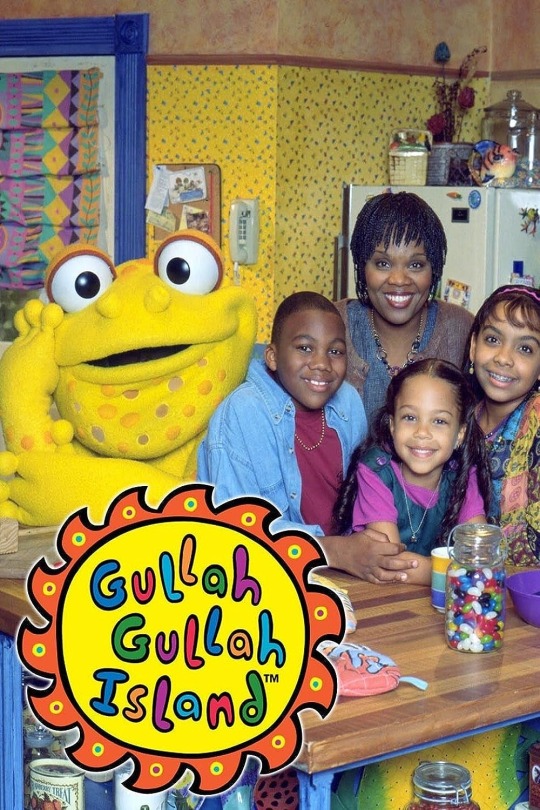
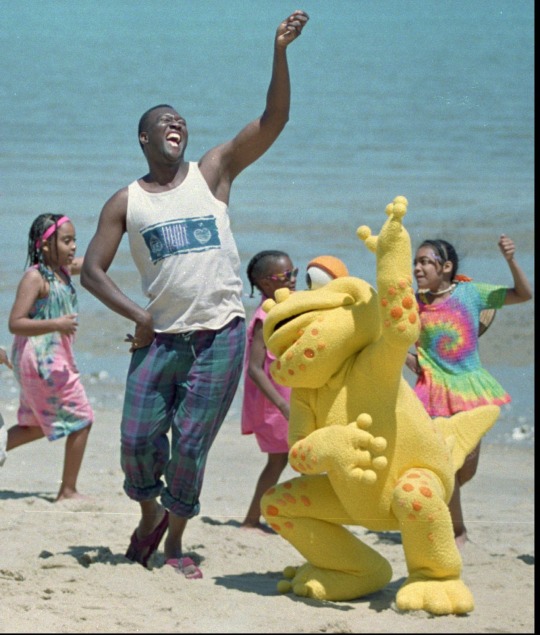

Commentary/Context/Memories: I actually saw the cast in concert, but my hyperactive self could not sit still, so I didn’t pay much attention. I feel so bad about it 😭
[Mod A: Awww please don’t feel bad about that! You were (likely) just a kid expressing your excitement in the way you knew best (unless you didn’t really want to go to the show). Concerts can be really hard to sit through as a kid regardless of if you’re interested in them or not! I also regret not really paying much attention to the Jonas Brothers (my first concert in 2008) bc I was not obsessed/had a crush on them the way my friend who took me had (should’ve been a sign I was gay in hindsight haha), even though I now think they had some great bops! Anyways back to the show: love the vibes of this show! I am normally creeped out by mascot costumes, but their friend Binyah Binyah Poliwog seems like a friendly lil frog! This show was a music-based show that aimed to educate kids about Gullah culture, who are an African American cultural community based along the coastline of North/South Carolina, Florida, Georgia and the Sea Islands that has a specific language and prominent arts/music culture because of relative isolation/shared African cultural heritage, the language is also known as Geechee (related to Creole). The show shared songs, art styles, dance, and stories important to the Gullah culture! I would like to learn more about this, because while I did know about Creole, I don’t know much about Gullah culture (so very glad to learn through researching this show!)]
75 notes
·
View notes
Text

Are we losing the ability to write by hand?
We are far more likely to use our hands to type or swipe than pick up a pen. But in the process we are in danger of losing cognitive skills, sensory experience – and a connection to history
Humming away in offices on Capitol Hill, in the Pentagon and in the White House is a technology that represents the pragmatism, efficiency and unsentimental nature of American bureaucracy: the autopen. It is a device that stores a person’s signature, replicating it as needed using a mechanical arm that holds a real pen.
Like many technologies, this rudimentary robotic signature-maker has always provoked ambivalence. We invest signatures with meaning, particularly when the signer is well known. During the George W Bush administration, the secretary of defence, Donald Rumsfeld, generated a small wave of outrage when reporters revealed that he had been using an autopen for his signature on the condolence letters that he sent to the families of fallen soldiers.
Fans of singer Bob Dylan expressed ire when they discovered that the limited edition of his book The Philosophy of Modern Song, which cost nearly $600 and came with an official certificate “attesting to its having been individually signed by Dylan”, in fact had made unlimited use of an autopen. Dylan took the unusual step of issuing a statement on his Facebook page: “With contractual deadlines looming,” Dylan wrote, “the idea of using an autopen was suggested to me, along with the assurance that this kind of thing is done ‘all the time’ in the art and literary worlds.” He also acknowledged that: “Using a machine was an error in judgment and I want to rectify it immediately.”
Our mixed feelings about machine-made signatures make plain our broader relationship to handwriting: it offers a glimpse of individuality. Any time spent doing archival research is a humbling lesson in the challenges and rewards of deciphering the handwritten word. You come to know your long-dead subjects through the quirks of their handwriting; one man’s script becomes spidery and small when he writes something emotionally charged, while another’s pristine pages suggest the diligence of a medieval monk. The calligraphist Bernard Maisner argues that calligraphy, and handwriting more broadly, is “not meant to reproduce something over and over again. It’s meant to show the humanity, the responsiveness and variation within.”
But handwriting is disappearing. A high-school student who took the preliminary SAT used for college admittance in the US confessed to the Wall Street Journal that “audible gasps broke out in the room” when students learned they would have to write a one-sentence statement that all the work is the student’s own, in cursive, or joined-up handwriting. “Cursive? Most students my age have only encountered this foreign language in letters from Grandma.”
The Common Core State Standards for education in the US, which outline the skills students are expected to achieve at each grade level, no longer require students to learn cursive writing. Finland removed cursive writing from its schools in 2016, and Switzerland, among other countries, has also reduced instruction in cursive handwriting. One assessment claimed that more than 33% of students struggle to achieve competency in basic handwriting, meaning the ability to write legibly the letters of the alphabet (in both upper and lower case). “We’re trying to be realistic about skills that kids are going to need,” said one school board member in Greenville, South Carolina. “You can’t do everything. Something’s got to go.” Children who cannot write in cursive also can’t read it.
Schoolchildren are not the only ones who can no longer write or read cursive. Fewer and fewer of us put pen to paper to record our thoughts, correspond with friends, or even to jot down a grocery list. Instead of begging a celebrity for an autograph, we request a selfie. Many people no longer have the skill to do more than scrawl their name in an illegible script, and those who do will see that skill atrophy as they rely more on computers and smartphones. A newspaper in Toronto recorded the lament of a pastry instructor who realised that many of his culinary students couldn’t properly pipe an inscription in icing on a cake – their cursive writing was too shaky and indistinct to begin with.
As a practical skill in the digital world, handwriting seems useless. There is a term in Chinese, tibiwangzi, which means “take pen, forget character”. It describes how more frequent use of computers and smartphones has discouraged the use of traditional Chinese handwriting, including the ability to write traditional characters. Chinese children pick up a pen to write (“take pen”) but experience a kind of “character amnesia” when it comes to putting pen to paper (“forget character”). According to the China Youth Daily Social Survey Center, 4% of Chinese youth are “already living without handwriting”.
What does it mean to live without handwriting? The skill has deteriorated gradually, and many of us don’t notice our own loss until we’re asked to handwrite something and find ourselves bumbling as we put pen to paper. Some people still write in script for special occasions (a condolence letter, an elaborately calligraphed wedding invitation) or dash off a bastardised cursive on the rare occasions when they write a cheque, but apart from teachers, few people insist on a continued place for handwriting in everyday life.
But we lose something when handwriting disappears. We lose measurable cognitive skills, and we also lose the pleasure of using our hands and a writing implement in a process that for thousands of years has allowed humans to make our thoughts visible to one another. We lose the sensory experience of ink and paper and the visual pleasure of the handwritten word. We lose the ability to read the words of the dead.
We are far more likely to use our hands to type or swipe. We communicate more but with less physical effort, forgetting the vast evolutionary history that fitted us for physical movement and expression as a means of understanding our world.
In 2000, physicians at Cedars-Sinai hospital in Los Angeles took a remedial handwriting course. “Many of our physicians don’t write legibly,” the chief of the medical staff explained to Science Daily. And unlike many professions, doctors’ bad writing can have serious consequences, including medical errors and even death; a woman in Texas won a $450,000 award after her husband took the wrong prescription medicine and died. The pharmacist had misread the doctor’s poorly handwritten instructions. Even though many medical records are now stored on computers, physicians still spend a lot of their time writing notes on charts or writing prescriptions by hand.
Clarity in handwriting isn’t merely an aid to communication. In some significant way, writing by hand, unlike tracing a letter or typing it, primes the brain for learning to read. Psychologists Pam Mueller and Daniel Oppenheimer compared students taking class notes by hand or on a laptop computer to test whether the medium mattered for student performance. Earlier studies of laptop use in the classroom had focused on how distracting computer use was for students. Not surprisingly, the answer was very distracting, and not just for the notetaker but for nearby peers as well.
Mueller and Oppenheimer instead studied how laptop use affected the learning process for students who used them. They found that “even when laptops are used solely to take notes, they may still be impairing learning because their use results in shallower processing”. In three different experiments, their research concluded that students who used laptop computers performed worse on conceptual questions in comparison with students who took notes by hand. “Laptop note takers’ tendency to transcribe lectures verbatim rather than processing information and reframing it in their own words is detrimental to learning,” they wrote. In other words, we retain information better when we write by hand because the slower pace of writing forces us to summarise as we write, as opposed to the greater speed of transcribing on a keyboard.
The researchers studying how technology transforms the way we write and learn are akin to ecologists who warn of species decline or environmental pollution. We face a future without handwriting. Researchers worry that abandoning the pen for the keyboard will lead to any number of unforeseen negative consequences. “The digitisation of writing entails radical transformations of the very act of writing at a sensorimotor, physical level and the (potentially far-reaching) implications of such transformations are far from properly understood,” notes Anne Mangen, who studies how technology transforms literacy. Writing on a keyboard with the words appearing on the screen is more “abstract and detached”, something she believes has “far-reaching implications, educationally and practically”. Like species decline, skills decline gradually.
It is popular to assume that we have replaced one old-fashioned, inefficient tool (handwriting) with a more convenient and efficient alternative (keyboarding). But like the decline of face-to-face interactions, we are not accounting for what we lose in this tradeoff for efficiency, and for the unrecoverable ways of learning and knowing, particularly for children. A child who has mastered the keyboard but grows into an adult who still struggles to sign his own name is not an example of progress.
As a physical act, writing requires dexterity in the hands and fingers as well as the forearms. The labour of writing by hand is also part of the pleasure of the experience, argues the novelist Mary Gordon. “I believe that the labour has virtue, because of its very physicality,” she writes. “For one thing it involves flesh, blood and the thingness of pen and paper, those anchors that remind us that, however thoroughly we lose ourselves in the vortex of our invention, we inhabit a corporeal world.”
Handwriting is also evocative in a way the printed word is not. Literature abounds with plot twists prompted by the appearance of a handwritten letter or signature. In Charles Dickens’s Bleak House, Lady Dedlock recognises the unusual handwriting of her former fiance, whom she thought dead, on a legal document, prompting the events that lead to the revelation of her greatest secret.
Our own handwriting can be a surprisingly effective prompt to memory. When American chef and cookbook author Deborah Madison stumbled upon some old handwritten recipes from the 1970s, she was transported back in time. Jotted down in brown notebooks along with notes and doodles and food stains and lists of suppliers that she used for the restaurant Greens in San Francisco, the recipes were “a record of time spent fitting new thoughts together”, she wrote. “At times it looks careful and deliberate. Other times my hand gets distracted and strays, looks sloppy and tired. But mostly it conveys such a deep sense of discovery that reading through these notebooks, I am reinfected with the obsessive excitement I felt then.” She doesn’t think the same feeling would emerge from a list written on a computer: “There’s much to be said for the mark of the hand.”
The novelist Mohsin Hamid takes notes by hand in notebooks and tries to remove himself from the online world when he is working on a novel, although he writes his novels on a computer. “The technology is shaping me, configuring me” when he uses it, he told the BBC, and he sees danger in embracing machine-like ways of doing things. The human way of doing things imposes limits, depending on our tools. Ten fingers can fly across a keyboard, but the experience of writing with a pen or pencil in one hand requires more patience. The average American can type 40 words a minute but can only write 13 words a minute by hand. As the calligraphist Paul Antonio notes, when he teaches children to write, he is really teaching them to slow down.
As the IT way of looking at the world replaces other ways of knowing, our wilful deskilling of longstanding human activities is not only happening with handwriting. Other embodied skills, also valuable, are at risk of disappearing.
“When we focus on making a physical object, or on playing a musical instrument, our concentration level is mainly self-directed,” the sociologist Richard Sennett argues. The act of manipulating a tool or of drawing a bow across a string forces us to feel and do simultaneously, and the more skilled we become at the act, the less we have to think about what we are doing. This form of “situated cognition”, as Sennett calls it, takes time to develop. It also forces us to slow down, as we see when we study people who make things by hand. “Part of craft’s anchoring role is that it helps to slow down labour,” Sennett told American Craft magazine. “Making is thinking.”
Lee Miller, a bootmaker in Austin, Texas, spends up to 40 hours hand-crafting a single pair of boots using tools that are more than 100 years old. Miller notes how the time dedicated to his craft is inseparable from what he creates. “No automated machine can do as fine work as the human hand can,” he argues. His customers, who are willing to wait years for the custom boots he makes, agree.
The significance of the handmade object derives from our knowledge of the time and effort and skill that went into making it; even the most sophisticated machine churning out identically sophisticated objects doesn’t inspire the same feeling. “We are knowing as well as sensing creatures,” the philosopher Julian Baggini writes. “Knowing where things come from, and how their makers are treated, does and should affect how we feel about them.” One need not belong to the elite to enjoy the luxury of owning handmade goods; platforms such as Etsy offer a wide array of handmade goods for every budget.
Some critics argue that our desire for handmade goods is increasing because so much of what we buy is now mass-produced, alienating us from a human connection to the objects we use. This is perhaps one reason that the revelations of horrific working conditions at the Chinese factories that make iPhones prompted outrage. The recognition that these sleek technologies emerged from overworked – even suicidal – human hands changed the way we understood them, at least until the outrage faded and the new version of the iPhone landed in stores.
Our desire for the mark of the human hand hasn’t diminished. Today we satisfy it in a novel way, however. We embrace a vicarious form of craftsmanship comprised of images of well-made things rather than the things themselves. We look at perfectly prepared meals on Instagram, or the efforts of strangers on home remodelling TV shows and do-it-yourself videos on YouTube, which range in quality from highly produced plumbing tutorials to boring, badly lit snippets of people mowing their lawns (which still somehow garner tens of millions of views). This is in keeping with the growth of other vicarious pursuits.
New forms of hands-on making have arisen, forms more in step with our technological age, such as the maker movement, which grew out of a late-20th-century hacker culture that sought to give individuals more power over how their technologies worked. Chris Anderson, who left his position as editor of Wired magazine to join a DIY drone-making company, argues that this new breed of DIY tech tinkerers and 3D printing mavens are responding to a culture that has become too invested in the virtual. “Making something that starts virtual but quickly becomes tactile and usable in the everyday world is satisfying in a way that pure pixels are not,” he wrote, predicting that the growing number of “makerspaces” would usher in a new industrial revolution. Critics such as Evgeny Morozov argue that the movement hasn’t produced a revolution but rather another form of “consumerism and DIY tinkering” sponsored by large corporations and the US military.
On a beam in the library of 16th-century essayist Michel de Montaigne’s home near Périgord, France, is carved a liberal paraphrase of a passage from the book of Ecclesiastes: “You who do not know how the mind is joined to the body know nothing of the works of God.” Montaigne embraced the human body in all its glorious and alarming incarnations (his essays contain gleeful descriptions of his own and others’ bouts of flatulence) and he criticised the hypocrisy of those who deny their corporeality. Our bodies are one of the central ways we understand ourselves, Montaigne believed. They are a reminder of our frailty and a check on the ego. “And upon the highest throne in the world, we are seated, still, upon our arses,” he wrote.
The physical requirements of everyday life in Montaigne’s time were fundamentally different from our own, and far more difficult, prompting greater humility. Such humility is rare in our technological age. The mundane tasks we perform every day with our bodies seem insignificant compared with the powers available to us when midwifed by our new technologies. It’s easier, physically, to send a message to the other side of the world than it is to tie your own shoelace.
But our instruments and tools remain extensions of our bodies in crucial ways. As the computer scientist Joseph Weizenbaum observed in his book Computer Power and Human Reason, we must “internalise aspects of [our tools] in the form of kinesthetic and perceptual habits”. Our tools become part of us. In a similar way, our bodies help us find our way in the world. “The body is our first and most natural technical object,” the French sociologist Marcel Mauss observed.
Our choice of tools and the way we use them facilitate not only habits of hand but also habits of mind. Our embodied experiences shape not only how we learn to do mundane things, but also how we understand the world around us. In Wallace Stegner’s novel Angle of Repose, one of the characters describes the mores of an earlier generation: his grandmother, who grew up on a farm, “could kill a chicken, and dress it, and eat it afterward, with as little repugnance as her neighbour”. Her generation had a different relationship to the physical world, which was reflected in the way they understood its challenges. “When animals died, the family had to deal with their bodies; when people died, the family’s women laid them out.”
Today, we experience less discomfort and don’t confront our bodies’ failures as often. Our increased comfort may mean that we struggle more with our bodies’ inevitable decline, often using technology to prolong life for as long as possible.
Some of our disappearing habits, such as handwriting and drawing, might not seem important. They are modest skills whose benefits are experienced privately, cannot easily be monetised (unless you are that rare thing, a professional calligrapher), and whose use in daily life no longer makes sense for an increasing number of people.
Yet the quiet disappearance of handwriting from our lives shows how the extinction of certain experiences happens: experiences recede gradually, not through some top-down edict or bottom-up populist campaign. And we rationalise their obsolescence not as a loss but as another mark of progress and improvement. A skill fades, and with it a human experience that spans millennia. Even those experiences leave a trace, like the cave drawings in Altamira and Lascaux, painted about 40,000 years ago and hundreds of miles apart, which both contain images of the same thing: the human hand.
Handwriting’s rapid decline in a world dominated by screens is also a symbol of how thoughtlessly we’ve settled between the old and the new. New technologies don’t have to destroy old ways of doing things. The printing press didn’t destroy handwriting. There is no reason to assume the triumph of the keyboard and touchscreen over pen and paper is inevitable, or that software spells the end of drawing by hand, or that the encroachment of technology in the classroom need force out more traditional embodied forms of learning. We can achieve some form of coexistence, even if it is likely to be an uneasy rather than a peaceful one.
“For our flesh surrounds us with its own desires,” the poet Philip Larkin wrote. It also surrounds us with opportunities – to learn, to understand, to feel in a way that our vicarious, screen-based experiences do not. As our world becomes ever more saturated with images and virtualisations, we shouldn’t let our desire for alluring technologies eclipse the human need to see, touch and make things with our hands.
🔴 This is an edited extract from The Extinction of Experience: Reclaiming Our Humanity in a Digital World, published by the Bodley Head
Daily inspiration. Discover more photos at Just for Books…?
11 notes
·
View notes
Text
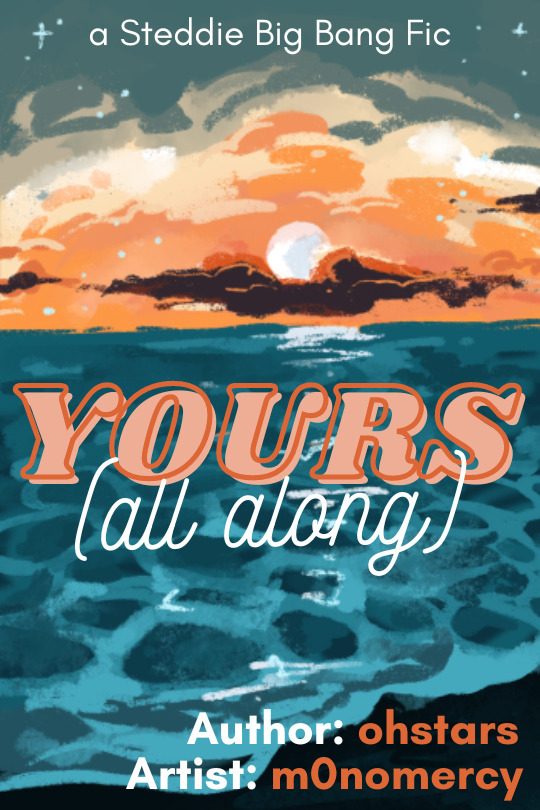
Yours (all along)
Written by @oh-stars, Art by @m0nomercy
Art is embedded in the story, but can also be found here: "The Harleys" Scene, "Beachside" Scene, Scenes from "Allies", "Bus Ride" Scene, "Happily Ever After" Scene (so many great pieces!!! Please show them some love!!!)
Rating: Mature
Archive Warning: No Warnings Apply
91,579 words, 16/16 chapters COMPLETE
Relationships: Steve Harrington/Eddie Munson, Robin Buckley & Steve Harrington
Characters: Eddie Munson, Steve Harrington, Robin Buckley, Original Child Character(s), Wayne Munson, Steve Harrington's Parents
Tags: Alternate Universe - Canon Divergence, Future Fic, Teacher Steve Harrington, Teacher Eddie Munson, Slow Burn, Pining, Misunderstandings, Fake Marriage, lavender marriage, Parent Steve Harrington, Cancer, childhood cancer, Steve Harrington Has Good Parents, Closeted Character, Angst with a Happy Ending, Angst, Everybody Lives, Gay Eddie Munson, Bisexual Steve Harrington, Steddie Big Bang 2023 (Stranger Things)
Summary:
Eddie Munson has spent the last ten years trying to move on from the collapse of Hawkins. Now he's starting at a new school on the coast of South Carolina with the hopes that he can find some kind of peace in this new life of his. Of course, that's turned on his head when a freshman decides to get under his skin and when that freshman's parents happen to be his nemesis (and love of his life) and one of his former best friends? Eddie's certain the universe has it in for him. Now he has to navigate teaching his enemy's child and dealing with the Incident that started it all, that he's been running away from this whole time. Is it time to start running? Or will Eddie finally be brave enough to tackle his feelings head on?
Thanks to my beta and friends, @lady-lostmind, @bifuriouswaterbender, and everyone in the @steddiebang server and the @steddieholidayexchange server for being a wonderful writing community!!
I'm so glad I saw this through, and I can't thank you all enough for inspiring me to continue!
This fic is now complete, thank you all for reading!!!
#ohstars fic#steddie fic#steddie#stranger things#steve harrington#eddie munson#steddie big bang#steddiebigbang#steddie big bang 2023
48 notes
·
View notes
Text






























2023 In Memoriam Part 12
Sharifa Fadel, 84
Bob Goody, 71
Bishop Beningo Luigi Papa, 87
Traute Lafrenz Page, 103
Bishop Augusto Lauro, 99
Ian Falconer, 63
Lisa Janti, 89
Tom Love, 85
Bill Siderewicz, 87
Peterson Zah, 85
Chaim Topol, 87
Bert I. Gordon, 100
Robert Blake, 89
Mark Crutcher III, 74
Chris Greeley, 60
(Ernest) McNeil Moore, 89
Otis Taylor, 80
Ken Wagner, 75
Jesús Alou, 80
(George) Dick Haley; Jr., 85
Itō Masatoshi, 98
Bishop Angel Hobayan, 93
Bishop Alexandru Mesian, 86
Harry Grant; Jr., 95
Michel Peyramaure, 101
Bishop J. Edward Troy, 91
Chris Cooper, 44
Felton Spencer, 55
Joe Pepitone, 82
Bob Breitenstein, 79
#Religion#Tributes#Music#Egypt#Movies#TV Shows#Books#U.K.#Italy#Germany#South Carolina#Art#Comics#Connecticut#Poland#Oklahoma#Sports#Football#Nebraska#Politics#Arizona#Israel#Wisconsin#New Jersey#Alabama#Texas#Maine#Baseball#Dominican Republic#Pennsylvania
0 notes